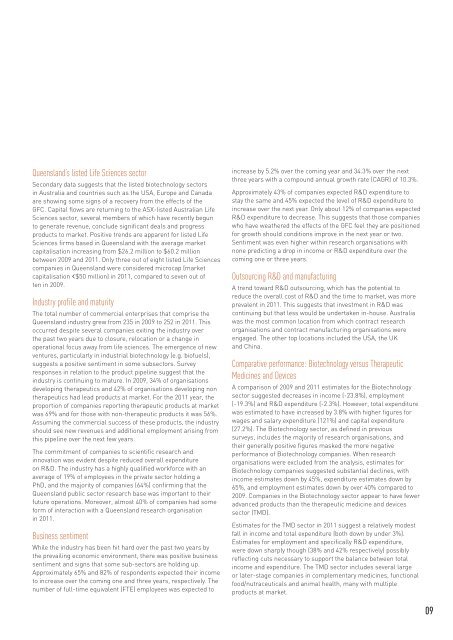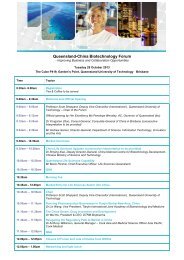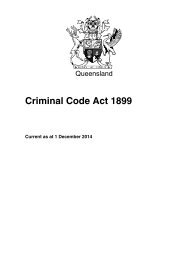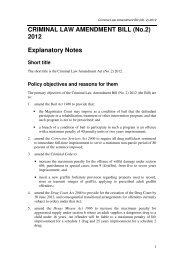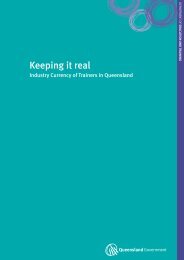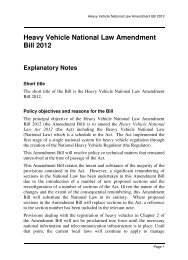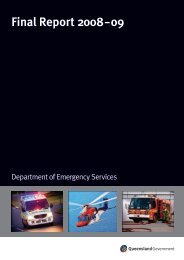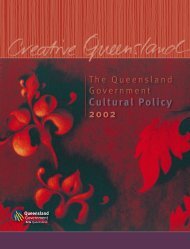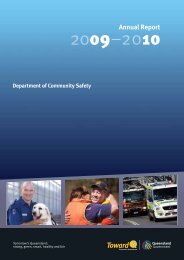Queensland Life Sciences Industry Report 2012 (PDF, 3.5MB)
Queensland Life Sciences Industry Report 2012 (PDF, 3.5MB)
Queensland Life Sciences Industry Report 2012 (PDF, 3.5MB)
You also want an ePaper? Increase the reach of your titles
YUMPU automatically turns print PDFs into web optimized ePapers that Google loves.
<strong>Queensland</strong>’s listed <strong>Life</strong> <strong>Sciences</strong> sector<br />
Secondary data suggests that the listed biotechnology sectors<br />
in Australia and countries such as the USA, Europe and Canada<br />
are showing some signs of a recovery from the effects of the<br />
GFC. Capital flows are returning to the ASX-listed Australian <strong>Life</strong><br />
<strong>Sciences</strong> sector, several members of which have recently begun<br />
to generate revenue, conclude significant deals and progress<br />
products to market. Positive trends are apparent for listed <strong>Life</strong><br />
<strong>Sciences</strong> firms based in <strong>Queensland</strong> with the average market<br />
capitalisation increasing from $26.2 million to $60.2 million<br />
between 2009 and 2011. Only three out of eight listed <strong>Life</strong> <strong>Sciences</strong><br />
companies in <strong>Queensland</strong> were considered microcap (market<br />
capitalisation ‹$50 million) in 2011, compared to seven out of<br />
ten in 2009.<br />
<strong>Industry</strong> profile and maturity<br />
The total number of commercial enterprises that comprise the<br />
<strong>Queensland</strong> industry grew from 235 in 2009 to 252 in 2011. This<br />
occurred despite several companies exiting the industry over<br />
the past two years due to closure, relocation or a change in<br />
operational focus away from life sciences. The emergence of new<br />
ventures, particularly in industrial biotechnology (e.g. biofuels),<br />
suggests a positive sentiment in some subsectors. Survey<br />
responses in relation to the product pipeline suggest that the<br />
industry is continuing to mature. In 2009, 34% of organisations<br />
developing therapeutics and 42% of organisations developing non<br />
therapeutics had lead products at market. For the 2011 year, the<br />
proportion of companies reporting therapeutic products at market<br />
was 69% and for those with non-therapeutic products it was 56%.<br />
Assuming the commercial success of these products, the industry<br />
should see new revenues and additional employment arising from<br />
this pipeline over the next few years.<br />
The commitment of companies to scientific research and<br />
innovation was evident despite reduced overall expenditure<br />
on R&D. The industry has a highly qualified workforce with an<br />
average of 19% of employees in the private sector holding a<br />
PhD, and the majority of companies (64%) confirming that the<br />
<strong>Queensland</strong> public sector research base was important to their<br />
future operations. Moreover, almost 40% of companies had some<br />
form of interaction with a <strong>Queensland</strong> research organisation<br />
in 2011.<br />
Business sentiment<br />
While the industry has been hit hard over the past two years by<br />
the prevailing economic environment, there was positive business<br />
sentiment and signs that some sub-sectors are holding up.<br />
Approximately 65% and 82% of respondents expected their income<br />
to increase over the coming one and three years, respectively. The<br />
number of full-time equivalent (FTE) employees was expected to<br />
increase by 5.2% over the coming year and 34.3% over the next<br />
three years with a compound annual growth rate (CAGR) of 10.3%.<br />
Approximately 43% of companies expected R&D expenditure to<br />
stay the same and 45% expected the level of R&D expenditure to<br />
increase over the next year. Only about 12% of companies expected<br />
R&D expenditure to decrease. This suggests that those companies<br />
who have weathered the effects of the GFC feel they are positioned<br />
for growth should conditions improve in the next year or two.<br />
Sentiment was even higher within research organisations with<br />
none predicting a drop in income or R&D expenditure over the<br />
coming one or three years.<br />
Outsourcing R&D and manufacturing<br />
A trend toward R&D outsourcing, which has the potential to<br />
reduce the overall cost of R&D and the time to market, was more<br />
prevalent in 2011. This suggests that investment in R&D was<br />
continuing but that less would be undertaken in-house. Australia<br />
was the most common location from which contract research<br />
organisations and contract manufacturing organisations were<br />
engaged. The other top locations included the USA, the UK<br />
and China.<br />
Comparative performance: Biotechnology versus Therapeutic<br />
Medicines and Devices<br />
A comparison of 2009 and 2011 estimates for the Biotechnology<br />
sector suggested decreases in income (-23.8%), employment<br />
(-19.3%) and R&D expenditure (-2.3%). However, total expenditure<br />
was estimated to have increased by 3.8% with higher figures for<br />
wages and salary expenditure (121%) and capital expenditure<br />
(27.2%). The Biotechnology sector, as defined in previous<br />
surveys, includes the majority of research organisations, and<br />
their generally positive figures masked the more negative<br />
performance of Biotechnology companies. When research<br />
organisations were excluded from the analysis, estimates for<br />
Biotechnology companies suggested substantial declines, with<br />
income estimates down by 45%, expenditure estimates down by<br />
65%, and employment estimates down by over 40% compared to<br />
2009. Companies in the Biotechnology sector appear to have fewer<br />
advanced products than the therapeutic medicine and devices<br />
sector (TMD).<br />
Estimates for the TMD sector in 2011 suggest a relatively modest<br />
fall in income and total expenditure (both down by under 3%).<br />
Estimates for employment and specifically R&D expenditure,<br />
were down sharply though (38% and 42% respectively) possibly<br />
reflecting cuts necessary to support the balance between total<br />
income and expenditure. The TMD sector includes several large<br />
or later-stage companies in complementary medicines, functional<br />
food/nutraceuticals and animal health, many with multiple<br />
products at market.<br />
09


